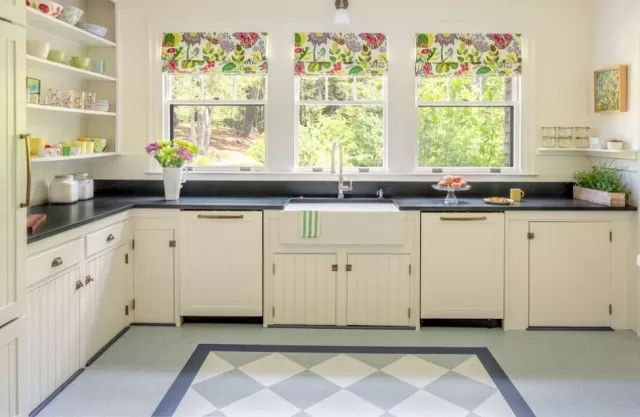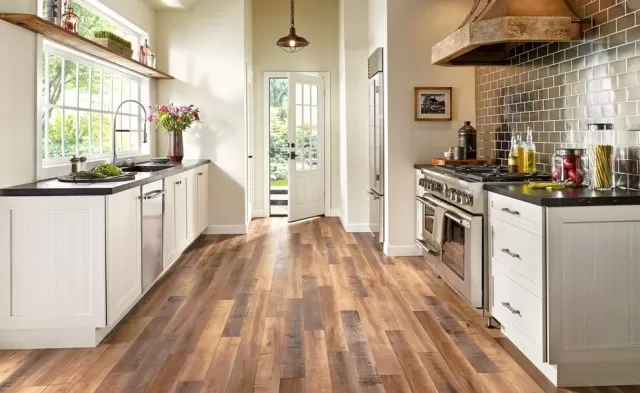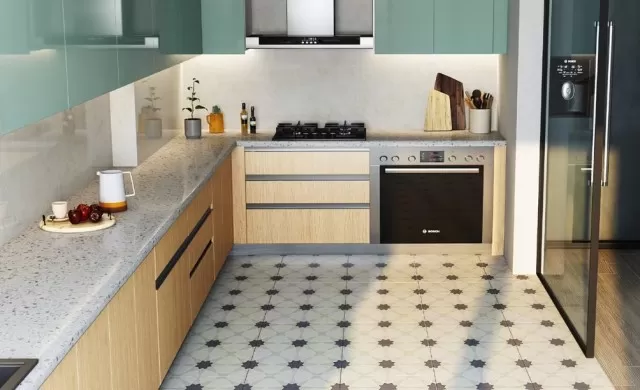No matter what type of flooring you have, there are certain daily cleaning tasks you can do for kitchen floors to minimize dirt and grime.
Regular sweeping helps prevent the accumulation of crumbs, pet hair, and debris brought in from outside.
Additionally, mopping every week effectively removes sticky grease and residue that can result from meal preparation. However, it’s crucial to understand the appropriate cleaning methods for different flooring materials like tile, linoleum, and wood.
Using the wrong Cleaning Solutions, particularly those with acidic properties, can potentially cause damage. To help you maintain your kitchen floors, here are the recommended cleaning options for each type of flooring material.
Guidebook for Cleaning the Kitchen Floors

Maintaining clean kitchen floors is essential, regardless of the type of flooring material you have.
By following the appropriate cleaning methods, you can keep your floors in great condition. Here’s how to clean different types of kitchen floors and make your floor cleaner:
Cleaning Kitchen Floor Tiles:
For ceramic tile floors, use a mixture of warm water and mild detergent or liquid Dish Soap.
Avoid sponge mops and air-drying the floor to prevent water spots. To clean grout lines, create a paste with water and baking soda and scrub with a soft bristle brush.
Rinse and dry with a microfiber towel.

Cleaning Kitchen Floor Linoleum:
Control grit and soil on linoleum floors by regularly wiping them with a damp mop.
For deeper cleanings, choose a nonabrasive all-purpose cleaner or a mild vinegar and water solution.
Cleaning Laminate Kitchen Floors:
Light mopping with a gentle cleanser is suitable for laminate floors.
Create a homemade laminate floor cleaner by mixing vinegar with water. Avoid excessive water and dry the floor with a microfiber cloth to prevent a cloudy finish.
Avoid wax, acrylic products, and bleach as they can damage the floor’s finish.

Cleaning Wood Kitchen Floors:
Sweep regularly and dry mop weekly to maintain hardwood floors.
Deep clean once or twice a year using a hardwood mop and specialized wood floor cleaner. Mop with a slightly damp mop, avoiding standing water, and wipe up excess liquid promptly to prevent damage.

Making Your Kitchen Floor Cleaner:
To protect and extend the life of your kitchen floors, use a gentle cleaner.
Avoid abrasive cleaners and follow the manufacturer’s recommendations. For a DIY solution, you can Use baking soda and vinegar for all flooring types except natural stone and hardwood.
Cleaning with Baking Soda and Vinegar:
Create a DIY cleaning solution by combining water, dishwashing detergent, baking soda, and distilled white vinegar.
Spray the mixture onto the floor, mop off, and rinse thoroughly with warm water.
Cleaning with Dish Soap:
Dish soap is effective for resilient flooring materials like linoleum, vinyl, and ceramic tile.
Mix dish soap with warm water and use the solution to mop the floors. Avoid using dish soap on wood floors, and check the manufacturer’s recommendations for laminate flooring.
Remember to always follow the specific guidelines for your flooring type to ensure effective and safe cleaning.
*The information is for reference only.